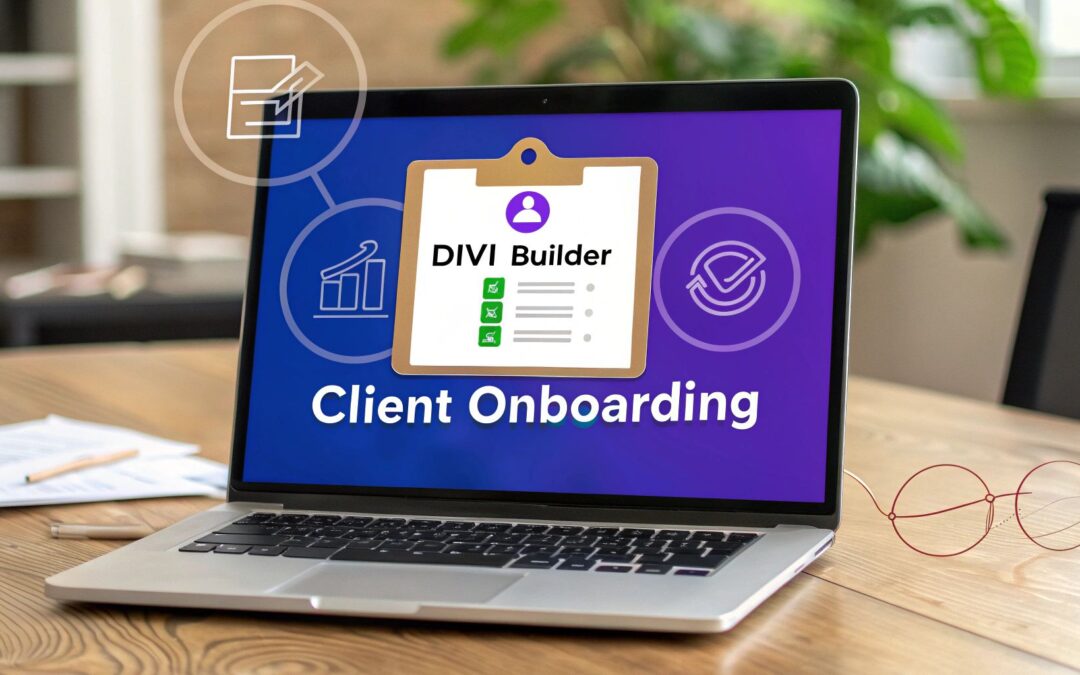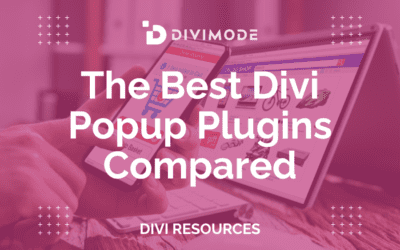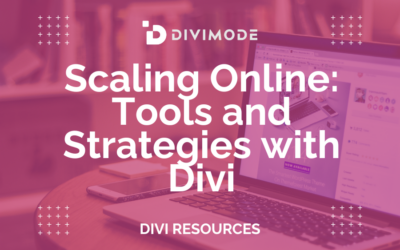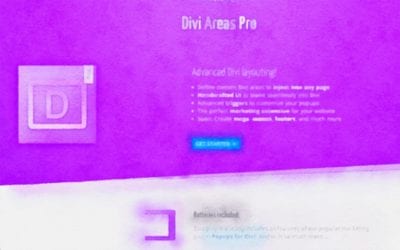The journey with a new client doesn't start with the first project; it begins the moment they sign on. This initial phase, client onboarding, is your single greatest opportunity to set the tone for a successful, long-term relationship. A haphazard welcome can lead to confusion, frustration, and early churn. A masterfully executed one builds trust, demonstrates value, and transforms new customers into loyal advocates.
This guide moves beyond generic advice to provide 8 essential client onboarding best practices with actionable strategies you can implement today. We will explore how to create personalized welcomes, set clear expectations with milestone-based journeys, and demonstrate value from day one. These structured touchpoints are critical for shaping a positive initial perception. To ensure your client's initial experience is flawless and continuously refined, explore methods to improve user experience design by applying real-world data and feedback loops.
For Divi users, we'll also include specific tips on how you can leverage tools to automate and enhance these critical first steps. By following these best practices, you can ensure your onboarding process is as impressive and professional as the websites you build, securing client confidence and setting the stage for lasting partnerships.
1. Personalized Welcome Experience
The first interaction after a sale sets the tone for the entire client relationship. A personalized welcome experience is one of the most critical client onboarding best practices because it immediately validates the client's decision, making them feel seen and valued rather than like just another number. This approach moves beyond generic "Welcome!" emails to create a tailored journey that acknowledges the client's specific goals, industry, and challenges discussed during the sales process.
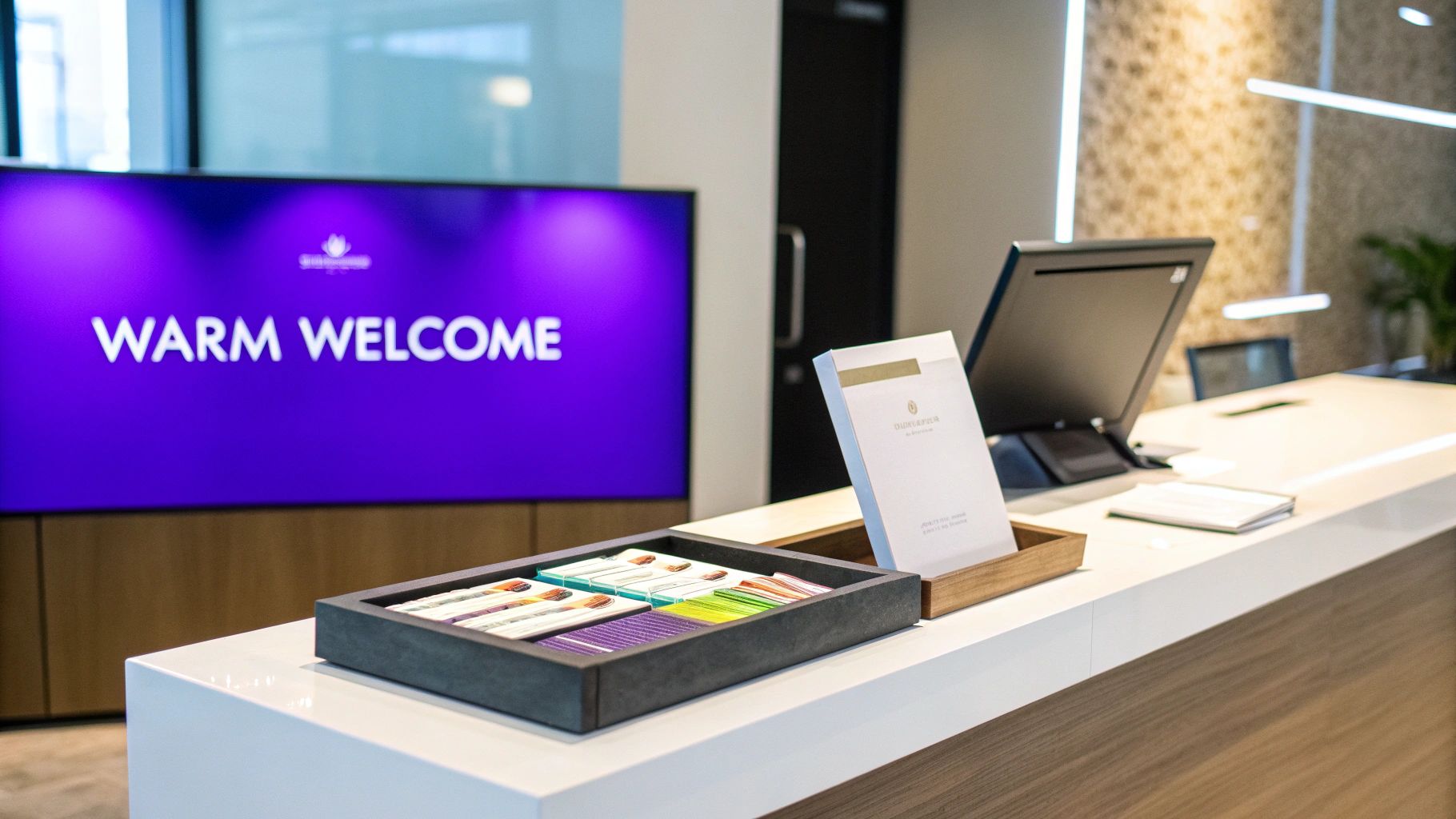
This strategy is about demonstrating that you’ve been listening. For instance, Salesforce excels by creating custom implementation roadmaps based on a client's specific industry and company size, ensuring relevance from day one. Similarly, HubSpot often has account managers send personalized welcome videos, mentioning specific objectives the new client hopes to achieve. This simple, human touch builds immediate rapport and trust.
How to Implement a Personalized Welcome
Creating a bespoke experience doesn't have to be complicated. The key is to leverage the information you've already gathered to show you understand their unique needs. For a deeper dive into making your digital assets feel more individual, check out these powerful website personalization examples.
Here are some actionable tips for Divi users and agencies:
- Segment Your Welcome: Create different onboarding sequences in your CRM or email marketing tool based on client type (e.g., e-commerce, local business, nonprofit). Customize the initial communication and resources shared for each segment.
- Use a Welcome Kit: For high-value projects, send a physical or digital welcome kit. A digital kit could be a password-protected page on your Divi site with a personalized video message, a project timeline, and links to all relevant documents.
- Reference Specific Goals: In your welcome email or kickoff call agenda, directly reference the primary goals the client mentioned during discovery calls. For example: "We're excited to start building the new e-commerce functionality to help you achieve your goal of a 20% increase in online sales."
- Customize the Project Dashboard: If you use a project management tool, create a client dashboard that is customized with their branding and project-specific milestones, not a generic template.
2. Clear Milestone-Based Onboarding Journey
Overwhelming a new client with a massive to-do list is a surefire way to cause confusion and stall progress. One of the most effective client onboarding best practices is to structure the process as a clear, milestone-based journey. This approach breaks down a complex project into a series of distinct, achievable steps, guiding clients from initial setup to full activation with a logical and manageable progression. Each milestone represents a meaningful achievement, providing clarity and building momentum through small, celebrated wins.
This strategy prevents client paralysis by focusing their attention on one key objective at a time. For instance, Asana excels with a checklist-based onboarding featuring milestones like 'Create your first project' and 'Invite team members.' Similarly, payroll software Gusto guides users through crucial steps like company setup, employee addition, and their first payroll run. This method provides a clear roadmap, shows immediate progress, and reinforces the value of your service at every stage.
The following diagram illustrates a typical three-phase milestone flow for a new client project, focusing on building from foundational setup to long-term optimization.
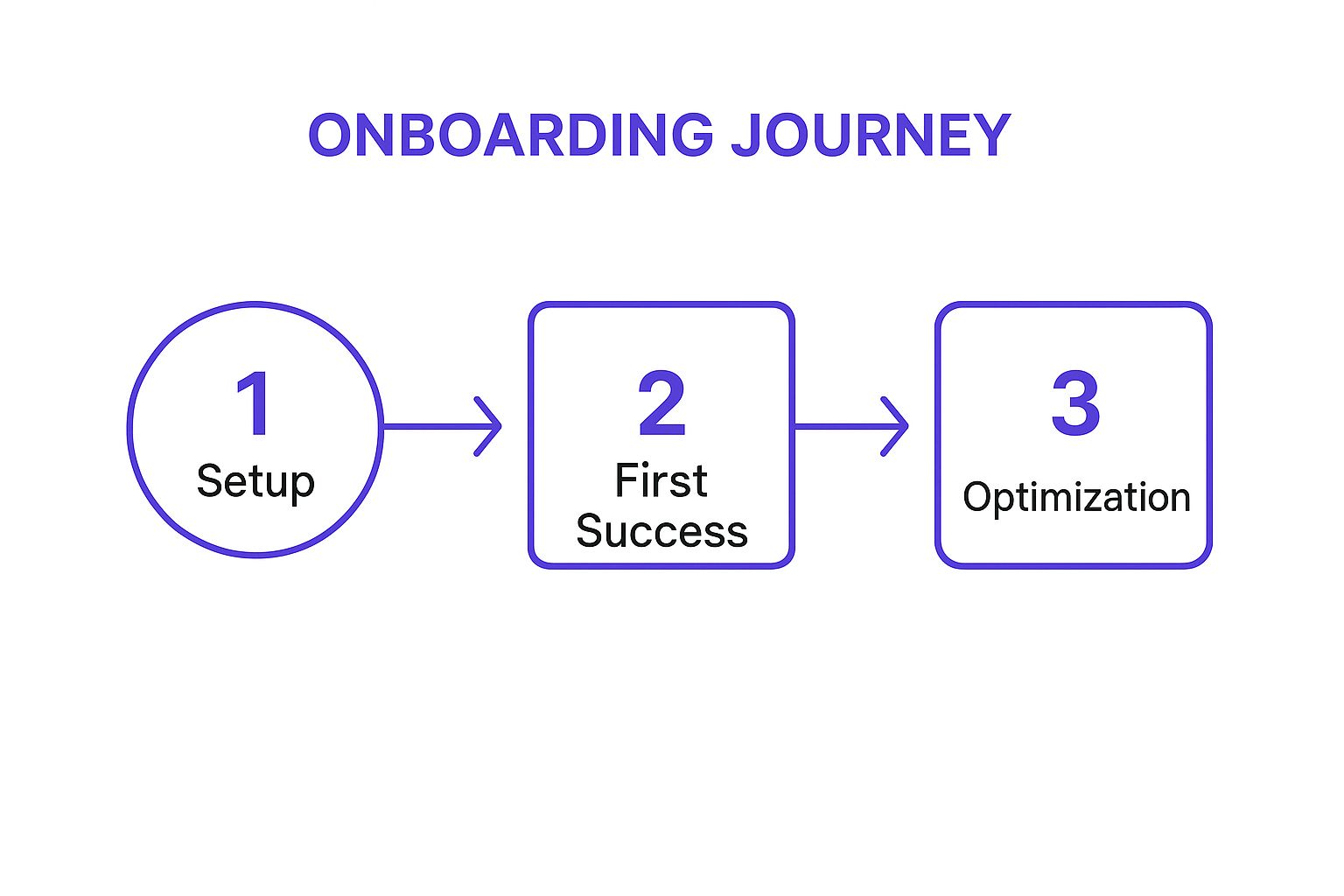
This visual process flow highlights how each completed stage naturally leads to the next, creating a sense of forward movement and accomplishment for the client.
How to Implement a Milestone-Based Journey
The goal is to design milestones around "aha moments" that quickly demonstrate the value of your partnership. For Divi agencies, this means moving beyond simple setup tasks to moments where the client sees tangible results from your work.
Here are some actionable tips for Divi users and agencies:
- Design for Early Wins: Make the first one or two milestones small and easy to achieve, like submitting brand assets or approving a style guide. This builds confidence and momentum right away.
- Visualize Progress: Use a project management tool with a client-facing portal to display a visual progress bar or checklist. Seeing the journey mapped out and their progress along it is highly motivating.
- Celebrate Completions: Set up automated emails or notifications to celebrate when a milestone is completed. A simple message like, "Congratulations! We've just completed the homepage design mockup," reinforces progress.
- Use Divi for Milestones: Create a dedicated, password-protected "Onboarding Hub" page on your Divi site. Use modules like the Accordion or Tabs to lay out each milestone, its tasks, and required resources, allowing clients to track everything in one place.
3. Proactive Communication and Expectation Setting
Nothing erodes client trust faster than unmet expectations and communication blackouts. Proactive communication is one of the most vital client onboarding best practices because it shifts the dynamic from reactive problem-solving to proactive guidance. This means anticipating client questions, setting clear expectations for timelines and responsibilities, and providing regular updates before they have to ask for them. This approach builds a foundation of transparency and reliability, preventing confusion and demonstrating your firm's professionalism.
This strategy is about leading the client through the process with confidence. For example, Zendesk immediately sends new clients a detailed 30-60-90 day onboarding roadmap, outlining every step and milestone. Similarly, Toast, a restaurant POS provider, sends daily text updates during hardware installation, keeping clients informed of progress in near real-time. This consistent flow of information eliminates uncertainty and empowers the client, making them feel secure in their investment.
How to Implement Proactive Communication
Building a structured communication plan ensures that no client feels left in the dark. The goal is to create a predictable rhythm of updates that reinforces progress and clarifies what's next. It’s about managing the flow of information to build momentum and maintain alignment.
Here are some actionable tips for Divi users and agencies:
- Create a Communication Calendar: For the first 90 days, map out a schedule of planned communications. This should include a welcome call, weekly progress emails, and key milestone check-ins. This simple tool sets a reliable cadence from day one.
- Use a RACI Matrix: In your project kickoff, present a simple chart defining who is Responsible, Accountable, Consulted, and Informed for key tasks. This clarifies roles and avoids confusion about who needs to provide feedback or approvals.
- Send Weekly Digest Emails: At the end of each week, send a concise email summarizing what was accomplished, what is planned for next week, and any outstanding items you need from the client. This keeps everyone aligned and documents progress.
- Establish a Primary Channel: While offering flexibility, clearly state your preferred communication channel (e.g., your project management tool, a specific email address) to keep all critical conversations organized and easily accessible.
- Develop an Onboarding FAQ: Create a dedicated page on your Divi site or a PDF that answers the most common questions new clients have. This resource empowers them to find answers instantly and shows you understand their common concerns.
4. Dedicated Onboarding Specialist or Team
Once a client signs on, transitioning them from a sales-led conversation to a long-term support relationship can be jarring. This is why having a dedicated onboarding specialist or team is one of the most effective client onboarding best practices for ensuring a smooth, focused, and expert-led initiation. This approach designates specific personnel whose primary responsibility is to guide new clients through the critical setup and early stages, ensuring nothing falls through the cracks before a handoff to an account manager.
This model provides continuity and deep expertise precisely when clients need it most. For instance, SaaS giants like Salesforce and HubSpot pioneered this by using specialists who live and breathe the onboarding journey. They understand common pitfalls, can proactively address questions, and are measured on client activation and time-to-value. Similarly, ADP assigns implementation specialists to new payroll accounts to manage the complex data migration and setup process, providing a single, knowledgeable point of contact.
How to Implement a Dedicated Onboarding Role
Even a small agency can adopt this focused approach. The goal is to create a clear, repeatable process managed by someone who excels at communication, project management, and empathy, ensuring clients feel supported from day one.
Here are some actionable tips for Divi users and agencies:
- Define the Role and Playbook: Create a comprehensive onboarding playbook that outlines every step, from the initial kickoff call to the final handoff. This document ensures consistency and empowers your specialist.
- Establish Handoff Protocols: Clearly define the criteria for when a client is officially "onboarded" and ready to be transitioned to their long-term account manager. A warm introduction call involving both the specialist and the manager is crucial.
- Focus on Key Metrics: Track the performance of your onboarding process using metrics like time-to-first-value (e.g., first major project milestone completed) and initial client satisfaction scores (NPS).
- Hire for Soft Skills: Prioritize candidates with exceptional communication, patience, and organizational skills. Technical knowledge can be taught, but a natural ability to build rapport and manage expectations is invaluable in this role.
5. Interactive Training and Education Program
Effective onboarding goes beyond providing access; it involves empowering clients to use your product or service successfully. An interactive training and education program is a cornerstone of the best client onboarding practices because it transforms passive information consumption into an engaging, hands-on learning experience. This method equips clients with the skills and confidence needed for long-term success by using video tutorials, live sessions, and interactive demos.
This approach focuses on learning by doing, which drastically improves knowledge retention and product adoption. For example, Salesforce’s Trailhead platform uses gamified learning paths with points and badges to make complex topics digestible and fun. Similarly, HubSpot Academy offers free certification courses that not only teach inbound marketing principles but also seamlessly onboard users onto their software. These programs turn training from a chore into a value-added benefit.
How to Implement Interactive Training
Building an educational program ensures your clients feel competent and supported from the very beginning. The goal is to make learning accessible and relevant to their specific use cases. To get ideas on making your training more engaging, you can explore these powerful examples of interactive content.
Here are some actionable tips for Divi users and agencies:
- Create Use-Case Based Tutorials: Instead of a feature-by-feature walkthrough of the Divi Builder, create short video tutorials based on common client goals, such as "How to Update Your Team Page" or "How to Add a New Blog Post."
- Offer Live "Office Hours": Schedule a recurring weekly or bi-weekly video call where clients can drop in to ask questions and get live support. This provides a valuable, high-touch resource without requiring individual training sessions.
- Build a Knowledge Base on Your Divi Site: Use a theme builder template to create a dedicated, searchable help center. Populate it with short articles, GIFs, and recorded training sessions that clients can access on-demand.
- Provide a Sandbox Environment: For complex projects, set up a staging site where clients can safely practice making edits and using new features without the fear of breaking their live website. This hands-on practice is invaluable for building confidence.
6. Data-Driven Onboarding Optimization
Guesswork has no place in a world-class client experience. One of the most impactful client onboarding best practices is to move from intuition-based to evidence-based process design by systematically tracking, analyzing, and acting on key metrics. This approach transforms onboarding from a static checklist into a dynamic system that continuously improves based on real client behavior and feedback.
This practice is about using data to answer critical questions: Where do clients get stuck? Which resources are most effective? What actions correlate with long-term success? For example, Intercom tracks feature adoption during onboarding and automatically triggers helpful messages if a client falls behind. Similarly, Gainsight incorporates onboarding progress into its customer Health Scores, creating an early warning system for potential churn. This data-first mindset ensures your process evolves to meet client needs effectively.
How to Implement Data-Driven Onboarding
The goal is to replace assumptions with insights, ensuring every adjustment you make is a measurable improvement. To continuously refine and enhance the efficiency of your onboarding flow, consider implementing robust business process optimization strategies to streamline every step.
Here are some actionable tips for Divi users and agencies:
- Define Success Metrics: Start by clearly defining what a "successful onboarding" looks like. Is it the client submitting all their content on time? Is it their team completing a training module? Set specific, measurable criteria.
- Track Key Milestones: Use your project management tool or CRM to track when clients complete critical milestones, such as attending the kickoff call, providing brand assets, or approving the initial wireframes. Identify bottlenecks where clients consistently get delayed.
- Combine Data Sources: Blend quantitative data (e.g., time to complete a phase) with qualitative feedback (e.g., post-onboarding survey responses). This provides a complete picture of both what is happening and why it's happening.
- Run A/B Tests: Experiment with different onboarding elements. For instance, test a detailed video tutorial against a written guide for your Divi site's backend and see which one leads to fewer support questions. This is similar to the testing principles outlined in our conversion rate optimization checklist.
7. Quick Wins and Early Value Demonstration
Nothing validates a client's investment faster than seeing tangible results. One of the most impactful client onboarding best practices is to strategically deliver a quick, meaningful win early in the process. This approach focuses on helping clients experience the core value of your service as soon as possible, which builds momentum, reinforces their purchasing decision, and fosters excitement for the full project scope.

This principle is powerfully demonstrated by platforms like Canva, which enables a user to create and download their first professional-looking design in just a few minutes. Similarly, Mailchimp guides new users to send their very first email campaign almost immediately. The goal isn't to complete the entire project overnight; it's to provide that initial "aha moment" that proves value and builds trust for the journey ahead.
How to Implement Quick Wins
Delivering early value requires you to identify the smallest action that produces a visible and meaningful outcome for your client. It’s about prioritizing impact over completeness in the initial stages to generate positive momentum.
Here are some actionable tips for Divi users and agencies:
- Identify the 'Aha Moment': Pinpoint the single most impactful result a client can achieve with your help. For a Divi project, this could be seeing a live, branded "Coming Soon" page or a functioning contact form that successfully sends a test submission to their inbox.
- Front-Load High-Impact Tasks: In your project plan, move a simple yet visually impressive task to the very beginning. For example, implement the new branding and color scheme on the homepage header and footer within the first few days so the client can see their new identity coming to life.
- Create a 'First Win' Checklist: Design your onboarding kickoff to guide the client toward a specific, achievable goal. For a WooCommerce store, this could be adding the first product or processing a test order successfully.
- Showcase and Celebrate the Win: Don't just complete the task; make the win visible. Send a celebratory email with a screenshot or a short screen recording demonstrating the new functionality. This helps the client see progress and share it with their own stakeholders.
8. Continuous Feedback Collection and Action
Client onboarding is not a one-way street where you simply deliver information. One of the most impactful client onboarding best practices is to establish a system for continuous feedback collection and, most importantly, to act on that input visibly. This practice transforms onboarding from a rigid process into an adaptive, client-centric experience. It shows clients that their opinion matters and that you are committed to refining the journey for their benefit.
This approach creates a powerful feedback loop that improves your processes while simultaneously strengthening the client relationship. For example, Superhuman's legendary white-glove onboarding involves intensive, one-on-one sessions where detailed feedback is a core component. Similarly, Notion sends brief, one-question surveys at key milestones, such as after a team first uses a new workspace, to capture in-the-moment sentiment and identify friction points early. This demonstrates a deep commitment to the user's success from the very beginning.
How to Implement Continuous Feedback
Integrating feedback collection should feel natural, not disruptive. The goal is to make it easy for clients to share their thoughts and for you to see trends and make improvements.
Here are some actionable tips for Divi users and agencies:
- Use Milestone Surveys: After completing a key project phase (e.g., wireframe approval, development handoff), send a short, automated survey using a tool like Gravity Forms or Typeform. Ask specific questions like, "How clear was the design presentation on a scale of 1-10?"
- Close the Loop: When a client provides feedback that leads to a process change, let them know. A simple email saying, "Thanks to your feedback on our project portal, we've now added a direct link to all mockups on the dashboard," makes clients feel heard and valued.
- Conduct Retrospective Interviews: For larger projects, schedule a brief call after the project launch to discuss the onboarding and development process. Ask what went well and what could have been smoother to gather deep, qualitative insights.
- Empower Your Team: Create a system where your team can flag recurring feedback and is empowered to make small, immediate improvements without bureaucratic delays. This agility ensures your onboarding process evolves constantly.
Client Onboarding Best Practices Comparison
| Onboarding Approach | Implementation Complexity 🔄 | Resource Requirements ⚡ | Expected Outcomes 📊 | Ideal Use Cases 💡 | Key Advantages ⭐ |
|---|---|---|---|---|---|
| Personalized Welcome Experience | Moderate to High – requires data, CRM integration, and systematization | Moderate – time, personalized communications, kits | Increased engagement, reduced churn, higher satisfaction | New clients in diverse segments needing tailored onboarding | Emotional connection, differentiation, improved retention |
| Clear Milestone-Based Onboarding Journey | Moderate – needs careful design and updates | Moderate – milestone creation, tracking tools | Clarity, reduced confusion, measurable progress | Clients benefiting from structured, stepwise onboarding | Progress visibility, momentum, easier resource allocation |
| Proactive Communication and Expectation Setting | Moderate – discipline and consistent multi-channel communication | Moderate to High – frequent check-ins and content creation | Builds trust, reduces anxiety and support tickets | Complex or high-stakes onboarding requiring transparency | Trust building, alignment, accountability |
| Dedicated Onboarding Specialist or Team | High – hiring, training, and coordination required | High – specialized staff allocation | Faster completion, higher quality, expert guidance | Complex onboarding needing expert human support | Expert attention, consistency, efficiency |
| Interactive Training and Education Program | High – significant content development and upkeep | High – training creation, live sessions, multimedia | Accelerated competency, adoption, and long-term reduction in support | Clients requiring deep knowledge and skill building | Measurable learning, product advocacy, monetizable content |
| Data-Driven Onboarding Optimization | High – analytics setup, data collection, and analysis | High – analytics tools and expertise | Continuous improvement, early risk identification | Organizations emphasizing evidence-based process improvements | Objective insights, ROI demonstration, prioritization |
| Quick Wins and Early Value Demonstration | Low to Moderate – focus on prioritization and sequencing | Low to Moderate – quick-win workflows and communications | Early confidence, momentum, reduced churn | Products/services with identifiable quick-impact features | Early motivation, advocacy, increased full onboarding completion |
| Continuous Feedback Collection and Action | Moderate to High – ongoing surveys and feedback processes | Moderate – survey tools, analysis, team time | Improved experience, trust, issue identification | All onboarding models wanting iterative improvement | Client insight, trust, proactive problem resolution |
From Onboarding to Ongoing Success: Your Next Steps
We've explored eight powerful client onboarding best practices, moving from the initial personalized welcome to the ongoing cycle of feedback and optimization. Mastering this process is not about a single checklist; it's about fundamentally shifting your perspective to prioritize the client's journey from day one. This commitment transforms a simple transaction into a lasting, successful partnership.
By implementing these strategies, you are not just preventing churn. You are actively building the foundation for client loyalty, advocacy, and long-term growth. When clients feel understood, guided, and valued from the start, they are more likely to achieve their goals, see the true value in your services, and become your biggest champions.
Turning Insights into Action
The key is to avoid feeling overwhelmed and instead focus on incremental, impactful change. You don't need to revolutionize your entire system overnight. The most effective approach is to identify your biggest onboarding bottleneck and start there.
Consider these actionable next steps to begin refining your process:
- Audit Your Current Process: Where are clients getting stuck? Where do you receive the most questions or complaints? Use the eight practices we've discussed as a lens to evaluate your existing workflow.
- Select One or Two High-Impact Changes: Perhaps your communication is reactive rather than proactive. Start by creating a communication schedule and a series of template emails. Or maybe clients are unsure what to do first; focus on creating a clear, milestone-based journey map.
- Leverage Your Divi Toolkit: As a Divi user, you have powerful tools at your disposal. Implement a "quick win" by using Divi Areas Pro to create a personalized welcome popup for new users logging into their dashboard. Build an interactive onboarding checklist using the Divi Builder to visually guide clients through essential setup tasks. These small enhancements create a remarkably professional and supportive experience.
The Lasting Impact of Excellent Onboarding
Ultimately, a world-class onboarding experience is one of your most significant competitive advantages. It directly influences client satisfaction, retention rates, and the overall health of your business. Each step, from demonstrating early value to proactively setting expectations, contributes to a system that nurtures client relationships for years to come.
Think of onboarding not as a preliminary phase but as the first, most critical chapter in your client's success story. By investing in these client onboarding best practices, you are ensuring that story is a long and prosperous one. Start refining your process today and watch as your client relationships transform from simple contracts into genuine, thriving partnerships.
Ready to elevate your Divi client onboarding with powerful, interactive elements? Divimode provides the essential tools, like Divi Areas Pro, to create dynamic popups, conditional content, and personalized user experiences that will set your onboarding process apart. Check out our suite of solutions at Divimode and start building better client relationships today.
